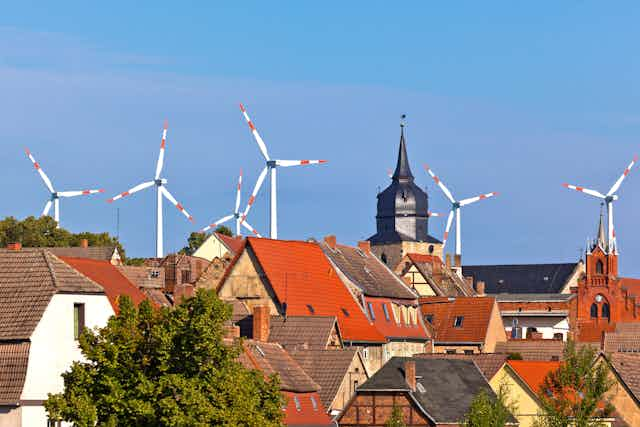The Australian government is reviewing our electricity market to make sure it can provide secure and reliable power in a rapidly changing world. Faced with the rise of renewable energy and limits on carbon pollution, The Conversation has asked experts what kind of future awaits the grid.
The Finkel review of the National Electricity Market is an opportunity to consider how Australia can transition its electricity system to be less carbon-intensive.
Germany’s energy transition is often held up as an incredible success story. Starting from a sector relying predominantly on fossil fuels and nuclear energy in the 1990s, renewable energy now provides about 30% of Germany’s electricity.
Germany is on track to achieve its 80% renewable target by 2050. This transformation has been the result of a range of policy measures.
The depth and breadth of these legal and regulatory reforms can provide valuable lessons for Australia.
Strong policy
Energy policy and climate policy have been expressly integrated in Germany since 2007. The government’s Energy Concept sets out Germany’s energy policy until 2050 with a strong focus on transforming the energy system.
It contains short, medium, and long-term targets for reducing greenhouse gases, increasing renewable energy, and improving energy efficiency in consumption, the building and transport sectors. While target-setting in a policy document may seem no more than a political gesture, it shows ambition and leads to political pressure for action. The policy targets for renewable energy are also binding as objectives in the German Renewable Energy Sources Act.
Notably, German legislation for the electricity industry, the Electricity Industry Act 2005, picks up on the ambition of transforming the energy system. It provides that electricity supply should not only be “cost-effective, consumer friendly and efficient”, but also “environmentally compatible” and “increasingly generated from renewable sources”. While the reference to environmental compatibility was already contained in the 1998 law, the express reference to renewables was added in 2011.
Australia, in contrast, continues to keep climate and energy policy separate. The National Electricity Objective remains narrowly-confined to achieving the reliable supply in an efficient way. Overall, Australia lacks long-term target setting, which stymies the necessary planning.
Supporting generators
Germany’s generous feed-in-tariffs (FITs) for renewable energy have been a major driver of transformation since they were first introduced in 1990. The FITs were set separately for each generation source. As a result they have funded a diverse range of renewable sources.
They also enabled the emergence of small and medium-sized renewable generators, which greatly reduced the political power of the big “gentailers” (generators and electricity retailers owned by the same companies).
Twenty-year payback periods and guaranteed dispatch for renewable energy made the FIT a major driver in Germany’s electricity transformation. They have also been a very costly way of supporting renewables.
With renewable energy now maturing, Germany is moving to increased market exposure for renewable energy through reverse auctions similar to mechanisms employed in the Australian Capital Territory.
The Australian Renewable Energy Target (RET) and state-based FITs have predominantly supported wind and rooftop solar. However, both are hampered by the lack of ambitious and long-term targets and considerable policy insecurity. Reverse auction schemes may provide a way forward to efficient support for a diverse range of renewables.
Transforming networks
A crucial part of Germany’s energy reforms is the focus on making networks more renewable-energy friendly. Germany’s renewable energy act requires network businesses (the owners of the poles and wires) to prioritise connecting renewable energy, and upgrade infrastructure where needed. This investment is overseen by the regulator.
No such mechanism for network investment to enable renewable energy exists in Australian network regulation.
German regulation now considers the whole system to strategically update electricity networks. This includes a nationwide and binding planning regime and investment into north-south interconnection. This is to help absorb the massive investment in wind generation in the north.
Network constraints are a major barrier to a 100% renewables future in Australia. Different modelling exercises for large amounts of renewable energy have been done by Beyond Zero Emissions or the Australian Energy Market Operator. Achieving these scenarios would require strategic and binding network planning across the whole of the NEM.
The Australian Energy Market Operator provides information to support efficient network planning, but actual investment decisions are in the hand of the network businesses. The network businesses continue to operate within each of the states. They invest in networks if necessary to guarantee reliable electricity supply.
There are no incentives for “greening” the network and strategically planning beyond state borders in the current regulatory framework.
Lessons for Australia
The German example is by no means a blueprint for Australia. Australia has different natural resources, existing network and generation infrastructure and the lack of neighbouring countries to connect to.
We can see though that a single instrument, be it a RET, Direct Action or a carbon price, will not be enough to enable a transformation.
Energy transitions need reform across the sector. This starts with a high level setting of ambitious, binding and long-term targets for emissions reductions and renewable energy.
It requires not only mechanisms to support generators financially, but also targeted regulation to adapt electricity networks to enable more renewables.
Reform in Germany is ongoing. There is now an impressive amount of legislation and amending legislation that deals with different aspects of the transition.
Crucially, the German government has shown willingness to go back and adapt policy instruments to changing circumstances or to address unintended consequences. Yet the overall commitment to the energy transition remains steady.
The terms of reference for the Finkel review recognise the need to integrate energy and climate policy in Australia. Hopefully it can take a more holistic view of the reforms necessary for decarbonisation of the industry.
A more detailed comparison of German and Australian reforms can be found here A Barrier for Australia’s Climate Commitments? Law, the Electricity Market and Transitioning the Stationary Electricity Sector.

